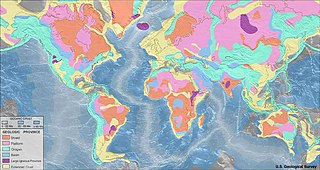 W
WIgneous rock, or magmatic rock, is one of the three main rock types, the others being sedimentary and metamorphic. Igneous rock is formed through the cooling and solidification of magma or lava. The magma can be derived from partial melts of existing rocks in either a planet's mantle or crust. Typically, the melting is caused by one or more of three processes: an increase in temperature, a decrease in pressure, or a change in composition. Solidification into rock occurs either below the surface as intrusive rocks or on the surface as extrusive rocks. Igneous rock may form with crystallization to form granular, crystalline rocks, or without crystallization to form natural glasses. Igneous rocks occur in a wide range of geological settings: shields, platforms, orogens, basins, large igneous provinces, extended crust and oceanic crust.
 W
WAmygdules or amygdales form when the gas bubbles or vesicles in volcanic lava are infilled with a secondary mineral such as calcite, quartz, chlorite or one of the zeolites. Amygdules usually form after the rock has been emplaced, and are often associated with low-temperature alteration. Amygdules may often be concentrically zoned. Rocks containing amygdules can be described as amygdaloidal.
 W
W"Apache tears" is the popular term for rounded pebbles of obsidian or "obsidianites" composed of black or dark-colored natural volcanic glass, usually of rhyolite composition and bearing conchoidal fracture. Also known by the lithologic term "marekanite", this variety of obsidian occurs as subrounded to subangular bodies up to about 2 inches in diameter, often bearing indented surfaces. Internally the pebbles sometimes contain fine bands or microlites and though in reflected light they appear black and opaque, they may be translucent in transmitted light. Apache tears fall between 5 and 5.5 in hardness on the Mohs scale.
 W
WCarbonatite is a type of intrusive or extrusive igneous rock defined by mineralogic composition consisting of greater than 50% carbonate minerals. Carbonatites may be confused with marble and may require geochemical verification.
 W
WCharnockite is applied to any orthopyroxene-bearing quartz-feldspar rock, formed at high temperature and pressure, commonly found in granulite facies metamorphic regions, as an end-member of the charnockite series.
 W
WChina stone is a medium grained, feldspar-rich partially kaolinised granite characterized by the absence of iron-bearing minerals. It is mainly used for making porcelain, hence the name, and coatings for paper.
 W
WClastic rocks are composed of fragments, or clasts, of pre-existing minerals and rock. A clast is a fragment of geological detritus, chunks and smaller grains of rock broken off other rocks by physical weathering. Geologists use the term clastic with reference to sedimentary rocks as well as to particles in sediment transport whether in suspension or as bed load, and in sediment deposits.
 W
WIn petrology, the mineral clinopyroxene is used for temperature and pressure calculations of the magma that produced igneous rock containing this mineral. Clinopyroxene thermobarometry is one of several geothermobarometers. Two things makes this method especially useful: first, clinopyroxene is a common phenocryst in igneous rocks and easy to identify; second, the crystallization of the jadeite component of clinopyroxene implies a growth in molar volume being thus a good indicator of pressure.
 W
WColumnar jointing is a geological structure where sets of intersecting closely spaced fractures, referred to as joints, result in the formation of a regular array of polygonal prisms, or columns. Columnar jointing occurs in many types of igneous rocks and forms as the rock cools and contracts. Columnar jointing can occur in cooling lava flows and ashflow tuffs (ignimbrites), as well as in some shallow intrusions. Columnar jointing also occurs rarely in sedimentary rocks if they have been heated by nearby hot magma.
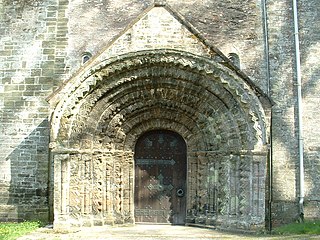 W
WElvan is a name used in Cornwall and Devon for the native varieties of quartz-porphyry. They are dispersed irregularly in the Upper Devonian series of rocks and some of them make very fine building stones. Greenstone is another name for this stone and it is often used for parts of buildings such as doorways so they can be finely carved. Most of the elvan quarries are now disused. Others are quarried in bulk for aggregates commonly used for road-building.
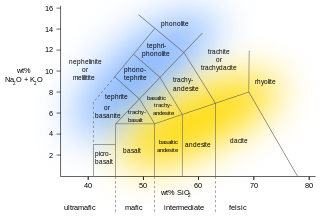 W
WExtrusive rock refers to the mode of igneous volcanic rock formation in which hot magma from inside the Earth flows out (extrudes) onto the surface as lava or explodes violently into the atmosphere to fall back as pyroclastics or tuff. In contrast, intrusive rock refers to rocks formed by magma which cools below the surface.
 W
WFlow banding is a geological term to describe bands or layers that can sometimes be seen in rock that formed from magma.
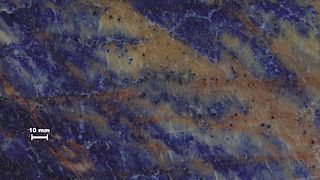 W
WFoidolite is a rare coarse-grained intrusive igneous rock in which more than 60% of light-coloured minerals are feldspathoids. Crystals of alkali feldspar, plagioclase, biotite, amphibole, pyroxene, and/or olivine may be present within the rock. The volcanic equivalents are termed foidite and phonolitic or tephritic foidites.
 W
WFractional crystallization, or crystal fractionation, is one of the most important geochemical and physical processes operating within crust and mantle of a rocky planetary body, such as the Earth. It is important in the formation of igneous rocks because it is one of the main processes of magmatic differentiation. Fractional crystallization is also important in the formation of sedimentary evaporite rocks.
 W
WThe Genesis Rock is a sample of Moon rock retrieved by Apollo 15 astronauts James Irwin and David Scott in 1971 during the second lunar EVA, at Spur crater. It is currently stored at the Lunar Sample Laboratory Facility in Houston, Texas. It is sample number 15415.
 W
WGlimmerite is an igneous rock consisting almost entirely of dark mica. Glimmerite has also been referred to as biotitite, though the use of this term to describe phlogopite-rich rocks has been criticized. Glimmerite may contain minor rutile and ilmenite, and variants of glimmerite bearing graphite, spinel, ankerite, pyrite, apatite, and the carbonate minerals calcite and dolomite have been described.
 W
WGraphic texture is commonly created by exsolution and devitrification and immiscibility processes in igneous rocks. It is called 'graphic' because the exsolved or devitrified minerals form lines and shapes which are reminiscent of writing.
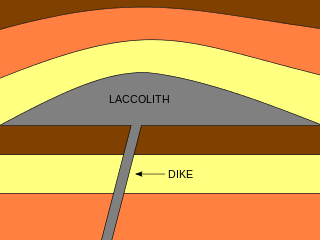 W
WA laccolith is a sheet-like intrusion that has been injected within or between layers of sedimentary rock. The pressure of the magma is high enough that the overlying strata are forced upward and folded, giving the laccolith a dome or mushroom-like form with a generally planar base. Over time, erosion can form small hills and even mountains around a central peak since the magma rock is likely more resistant to weathering than the host rock. The growth of laccoliths can take as little as a few months when associated with a single magma injection event, or up to hundreds or thousands of years by multiple magmatic pulses stacking sills on top of each other and deforming the host rock incrementally.
 W
WA large igneous province (LIP) is an extremely large accumulation of igneous rocks, including intrusive and extrusive, arising when magma travels through the crust towards the surface. The formation of LIPs is variously attributed to mantle plumes or to processes associated with divergent plate tectonics. The formation of some of the LIPs the past 500 million years coincide in time with mass extinctions and rapid climatic changes, which has led to numerous hypotheses about the causal relationships. LIPs are fundamentally different from any other currently active volcanoes or volcanic systems.
 W
WLava is molten rock (magma) that has been expelled from the interior of some planets and some of their moons. Magma is generated by the internal heat of the planet or moon and it is erupted as lava at volcanoes or through fractures in the crust, usually at temperatures from 700 to 1,200 °C. The solid rock resulting from subsequent cooling is also often described as lava.
 W
WA lava coil is a spiral or scroll-shaped lava formation occurring when relatively low viscosity lava such as Pahoehoe solidifies along a slow-moving shear zone in the flow. The shear produces a Kelvin–Helmholtz instability that forms spiral-shaped patterns. Depending on the side of the flow the spiral is clockwise or anti-clockwise. They have been observed on flows near Kilauea on Hawai'i, in Kenya and possibly on Mars.
 W
WLava pillars are common within collapsed sheet flow terrain. Lava pillars are hollow inside forming a pipe-like channel between the bottom and the top of a lava flow. They sometimes coalesce to form walls or can be attached to other pillars by natural bridges.
 W
WA layered intrusion is a large sill-like body of igneous rock which exhibits vertical layering or differences in composition and texture. These intrusions can be many kilometres in area covering from around 100 km2 (39 sq mi) to over 50,000 km2 (19,000 sq mi) and several hundred metres to over one kilometre (3,300 ft) in thickness. While most layered intrusions are Archean to Proterozoic in age, they may be any age such as the Cenozoic Skaergaard intrusion of east Greenland or the Rum layered intrusion in Scotland. Although most are ultramafic to mafic in composition, the Ilimaussaq intrusive complex of Greenland is an alkalic intrusion.
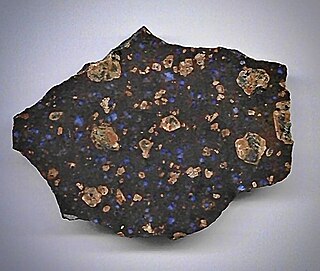 W
WLlanite is a porphyritic rhyolite with distinctive phenocrysts of blue quartz and perthitic feldspar. The brown, fine-grained groundmass consists of very small quartz, feldspar, and biotite mica crystals.
 W
WA lopolith is a large igneous intrusion which is lenticular in shape with a depressed central region. Lopoliths are generally concordant with the intruded strata with dike or funnel-shaped feeder bodies below the body. The term was first defined and used by Frank Fitch Grout during the early 1900s in describing the Duluth gabbro complex in northern Minnesota and adjacent Ontario.
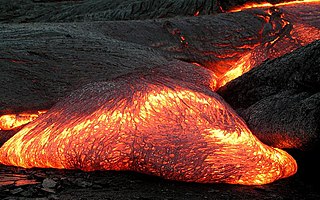 W
WMagma is the molten or semi-molten natural material from which all igneous rocks are formed. Magma is found beneath the surface of the Earth, and evidence of magmatism has also been discovered on other terrestrial planets and some natural satellites. Besides molten rock, magma may also contain suspended crystals and gas bubbles.
 W
WMagmatism is the emplacement of magma within and at the surface of the outer layers of a terrestrial planet, which solidifies as igneous rocks. It does so through magmatic activity or igneous activity, the production, intrusion and extrusion of magma or lava. Volcanism is the surface expression of magmatism.
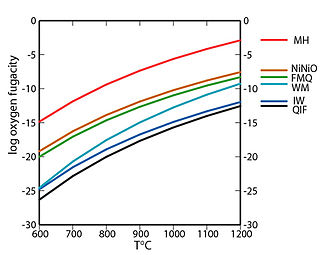 W
WIn geology, a redox buffer is an assemblage of minerals or compounds that constrains oxygen fugacity as a function of temperature. Knowledge of the redox conditions (or equivalently, oxygen fugacities) at which a rock forms and evolves can be important for interpreting the rock history. Iron, sulfur, and manganese are three of the relatively abundant elements in the Earth's crust that occur in more than one oxidation state. For instance, iron, the fourth most abundant element in the crust, exists as native iron, ferrous iron (Fe2+), and ferric iron (Fe3+). The redox state of a rock affects the relative proportions of the oxidation states of these elements and hence may determine both the minerals present and their compositions. If a rock contains pure minerals that constitute a redox buffer, then the oxygen fugacity of equilibration is defined by one of the curves in the accompanying fugacity-temperature diagram.
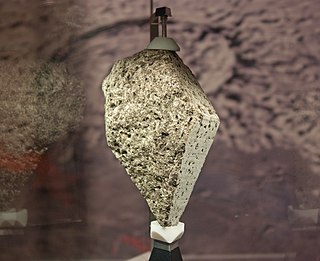 W
WMoon rock or lunar rock is rock that is found on the Earth's Moon. This includes lunar material collected during the course of human exploration of the Moon, and rock that has been ejected naturally from the Moon's surface and landed on the Earth as meteorites.
 W
WNakhlites are a group of Martian meteorites, named after the first one, Nakhla meteorite.
 W
WNelsonite is an igneous rock primarily constituted of ilmenite and apatite, with anatase, chlorite, phosphosiderite, talc and/or wavellite appearing as minor components. It was named for Nelson County, Virginia, and is also found in that state's Amherst and Roanoke counties. At one time, it was mined for the extraction of titanium dioxide. In 2016, the Virginia legislature designated it as the official State Rock of Virginia. While not mined in Virginia today, occurrences in New York, West Virginia and Quebec have been studied. Nelsonite is currently mined in China for rare-earth elements.
 W
WAn ophiolite is a section of Earth's oceanic crust and the underlying upper mantle that has been uplifted and exposed above sea level and often emplaced onto continental crustal rocks.
 W
WOphiolites are sequences of mafic to ultramafic rock generally believed to represent ancient oceanic lithosphere. They are distributed all across the world being all of them located at present or past orogenic belts, sites of mountain building processes.
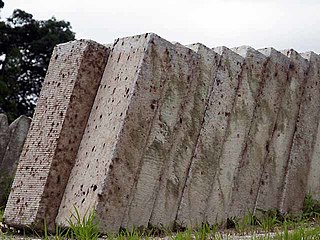 W
WŌya stone is an igneous rock, created from lava and ash. Ōya stone was famously used in the facing of Frank Lloyd Wright's Imperial Hotel in Tokyo. One reason this stone was used is because it has a warm texture and is easily carved, which allows much versatility. Ōya stone can have different colors and is also fireproof.
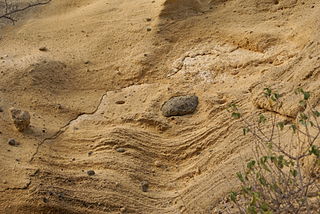 W
WPalagonite is an alteration product from the interaction of water with volcanic glass of chemical composition similar to basalt. Palagonite can also result from the interaction between water and basalt melt. The water flashes to steam on contact with the hot lava and the small fragments of lava react with the steam to form the light-colored palagonite tuff cones common in areas of basaltic eruptions in contact with water. An example is found in the pyroclastic cones of the Galapagos Islands. Charles Darwin recognized the origin of these cones during his visit to the islands. Palagonite can also be formed by a slower weathering of lava into palagonite, resulting in a thin, yellow-orange rind on the surface of the rock. The process of conversion of lava to palagonite is called palagonitization.
 W
WA pegmatite is an igneous rock, formed underground, with interlocking crystals usually larger than 2.5 cm in size (1 in). Most pegmatites are found in sheets of rock near large masses of igneous rocks called batholiths.
 W
WPeperino is an Italian name applied to a brown or grey volcanic tuff, containing fragments of basalt and limestone, with disseminated crystals of augite, mica, magnetite, leucite, and other similar minerals. The typical peperino occurs in the Alban Hills and in Soriano nel Cimino, near Rome, and was used by the ancients, under the name of lapis albanus, as a building stone and for the basins of fountains.
 W
WA peperite is a type of volcaniclastic rock consisting of sedimentary rock that contains fragments of younger igneous material and is formed when magma comes into contact with wet sediments. The term was originally used to describe rocks from the Limagne region of France, from the similarity in appearance of the granules of dark basalt in the light-coloured limestone to black pepper. Typically the igneous fragments are glassy and show chilled-margins to the sedimentary matrix, distinguishing them from clasts with a sedimentary origin.
 W
WPeraluminous rocks are igneous rocks that have a molecular proportion of aluminium oxide higher than the combination of sodium oxide, potassium oxide and calcium oxide. This contrasts with peralkaline in which the alkalis are higher, metaluminous where aluminium oxide concentration is lower than the combination, but above the alkalis, and subaluminous in which aluminia concentration is lower than the combination. Examples of peraluminous minerals include biotite, muscovite, cordierite, andalusite and garnet.
 W
WA phacolith is a pluton of igneous rock parallel to the bedding plane or foliation of folded country rock. More specifically, it is a typically lens-shaped pluton that occupies either the crest of an anticline or the trough of a syncline. In rare cases the body may extend as a sill from the crest of an anticline through the trough of an adjacent syncline, such that in cross section it has an S shape. In intensely folded terrain the hinge of folds would be areas of reduced pressure and thus potential sites for magma migration and emplacement.
 W
WPorphyry is a textural term for an igneous rock consisting of large-grained crystals such as feldspar or quartz dispersed in a fine-grained silicate rich, generally aphanitic matrix or groundmass. The larger crystals are called phenocrysts. In its non-geologic, traditional use, the term porphyry refers to the purple-red form of this stone, valued for its appearance.
 W
WPumice, called pumicite in its powdered or dust form, is a volcanic rock that consists of highly vesicular rough textured volcanic glass, which may or may not contain crystals. It is typically light colored. Scoria is another vesicular volcanic rock that differs from pumice in having larger vesicles, thicker vesicle walls and being dark colored and denser.
 W
WA QAPF diagram is a double ternary diagram which is used to classify igneous rocks based on mineralogic composition. The acronym QAPF stands for "Quartz, Alkali feldspar, Plagioclase, Feldspathoid (Foid)". These are the mineral groups used for classification in QAPF diagram. Q, A, P and F percentages are normalized.
 W
WQuartz-porphyry, in layman's terms, is a type of volcanic (igneous) rock containing large porphyritic crystals of quartz. These rocks are classified as hemi-crystalline acid rocks.
 W
WA sheet intrusion, or tabular intrusion, is a planar sheet of roughly the same thickness, that forms inside a pre-existing rock. When it cuts into another unlayered mass, or across layers, it is called a "dike". When it is formed between layers in a layered rock mass, it is called a "sill".
 W
WSovite is the coarse-grained variety of carbonatite, an intrusive, igneous rock. The finer-grained variety of carbonatite is known as alvikite. The two varieties are distinguished by minor and trace element compositions. Sovite is often a medium-to-coarse-grained calcite rock with variable accessory amphibole, biotite, pyrite, pyrochlore and fluorite.
 W
WIn petrology, spherulites are small, rounded bodies that commonly occur in vitreous igneous rocks. They are often visible in specimens of obsidian, pitchstone and rhyolite as globules about the size of millet seed or rice grain, with a duller luster than the surrounding glassy base of the rock, and when they are examined with a lens they prove to have a radiate fibrous structure.
 W
WTezontle is a porous, highly oxidized, volcanic rock used extensively in construction in Mexico. It is usually reddish in color due to iron oxide. Tezontle is a well-cemented, agglomeritic and scoriaceous rock.
 W
WA thunderegg is a nodule-like rock, similar to a filled geode, that is formed within rhyolitic volcanic ash layers. Thundereggs are rough spheres, most about the size of a baseball—though they can range from a little more than a centimeter to over a meter across. They usually contain centres of chalcedony which may have been fractured followed by deposition of agate, jasper or opal, either uniquely or in combination. Also frequently encountered are quartz and gypsum crystals, as well as various other mineral growths and inclusions. Thundereggs usually look like ordinary rocks on the outside, but slicing them in half and polishing them may reveal intricate patterns and colours. A characteristic feature of thundereggs is that the individual beds they come from can vary in appearance, though they can maintain a certain specific identity within them.
 W
WTonalite-trondhjemite-granodiorite rocks or TTG rocks are intrusive rocks with typical granitic composition but containing only a small portion of potassium feldspar. Tonalite, trondhjemite, and granodiorite often occur together in geological records, indicating similar petrogenetic processes. Post Archean TTG rocks are present in arc-related batholiths, as well as in ophiolites, while Archean TTG rocks are major components of Archean cratons.
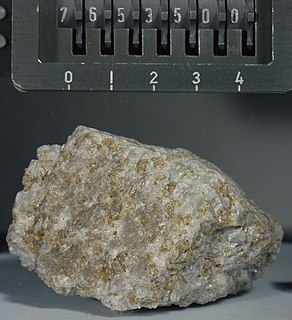 W
WTroctolite is a mafic intrusive rock type. It consists essentially of major but variable amounts of olivine and calcic plagioclase along with minor pyroxene. It is an olivine-rich anorthosite, or a pyroxene-depleted relative of gabbro. However, unlike gabbro, no troctolite corresponds in composition to a partial melt of peridotite. Thus, troctolite is necessarily a cumulate of crystals that have fractionated from melt.
 W
WTroctolite 76535 is a lunar sample discovered and collected on the Apollo 17 mission in 1972 in the Taurus–Littrow valley. It has a mass of about 156 grams (5.5 oz) and is about 5 centimetres (2.0 in) across at its widest point. It was collected by geologist astronaut Harrison Schmitt as part of a "rake sample" of lunar soil at Geology Station 6, near the base of the North Massif.
 W
WVariolites are mafic, igneous, and typically volcanic rocks, e.g. tholeiite, basalt or komatiite, that contain centimeter-scale spherical or globular structures, called varioles, in a fine-grained matrix. These structures are lighter colored than the host rock and typically range in diameter from 0.05mm to over 5 cm. In 1648, Aldrovandi created the term variolite for aphanitic or fine-grained igneous rocks containing varioles. The weathering of varioles often cause variolites to have a pock-marked appearance. In allusion to the pock-marked appearance of weathered surfaces of variolite, this term is derived from the Latin word, variola, for smallpox.